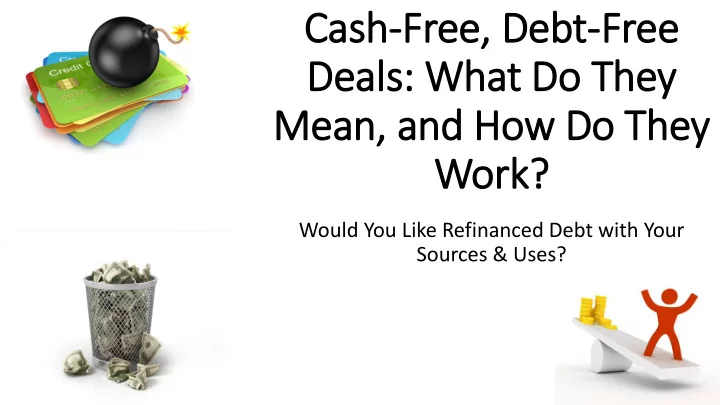

Cash-Free, Debt-Free Deals: What Do T They Mean, and How D Do They Work? Would You Like Refinanced Debt with Your Sources & Uses?
A Very ry Common Question… “When modeling a ‘Cash -Free, Debt- Free’ deal, and the Target has both Cash and Debt on its Balance Sheet, how do you adjust for it in a 3-statement model? I know Cash and Debt are both supposed to go to 0, but how do you make sure the Balance Sheet still balances?”
A Very ry Common Question… “Also, how do you record this type of deal in the Sources & Uses schedule? Do you show the Equity Value or Enterprise Value on the Uses side? Do you have any examples to show how this type of deal works?”
The Short Answer… • In a Cash-Free, Debt-Free Deal , the Target’s existing Cash and Debt balances go to 0 right after the deal closes • Sources & Uses: The Uses side should be based on Purchase Enterprise Value + Transaction Fees; Sources side is normal • Adjusting Offsets: Nothing is needed because Investor Equity changes to reflect the Cash used and Debt repaid • So: Total Uses increases by existing Debt and decreases by existing Cash, which means Total Sources changes as well
The Short Answer… • “Standard” (Non -Cash-Free, Debt-Free) Deal: The Target’s existing Cash and Debt do not necessarily go to 0 upon deal close • Example 1: Maybe the Target keeps some of its Cash on its Balance Sheet rather than using it to fund the deal • Example 2: Maybe the Acquirer assumes the Target’s Debt rather than repaying it and replacing it with new Debt • Bottom Line: More “options” and possibilities for the treatment of Cash and Debt in a standard deal
Excel l Tutorial • Illustrations: We’ll use a simplified LBO model here because it’s easier to see the changes with a single, standalone company • Change #1: We need a different Sources & Uses for both transaction scenarios – Investor Equity will change • Change #2: We need to add some checks for the deal type to the Cash, Debt, and Equity adjustments on the Balance Sheet • Change #3: In the Debt Schedule, we need to check for the deal type and link to the proper version of the S&U schedule for each tranche of Debt (including Assumed Debt)
Excel l Tutorial • Change #4: The IRR and Money-on-Money Multiple calculation at the end need to check for the deal type because the Investor Equity differs in each case • Does Any of This Matter? Well… kind of; the IRR changes by ~1 -2% depending on the Cash/Debt assumptions • But: Not enough to “move the needle” on an investment decision in most cases • Exceptions: Would make more of a difference if the company had a massive Cash balance, but that would also affect a standard deal!
Loose Ends on Cash-Free, Debt-Free Deals • Mechanics: If Debt > Cash, then the Target uses its entire Cash balance to repay as much Debt as it can, and the Acquirer repays the rest when it completes the deal (higher price) • Mechanics: If Cash > Debt, then the Target repays its entire Debt balance using its Cash… • Extra Cash: Target uses it to repurchase shares or issue a “Special Dividend” to its shareholders, or something similar • Result: Target’s Equity Value is lower, meaning the deal price is lower for the Acquirer
Recap and Summary • In a Cash-Free, Debt-Free Deal , the Target’s existing Cash and Debt balances go to 0 right after the deal closes • Sources & Uses: The Uses side should be based on Purchase Enterprise Value + Transaction Fees; Sources side is normal • “Standard” (Non -Cash-Free, Debt-Free) Deal: Target’s Cash and Debt do not necessarily go to 0 upon deal close • Deal Impact: For most companies, modest – different treatment for Cash and Debt affects Investor Equity a bit
Recap and Summary
Recommend
More recommend